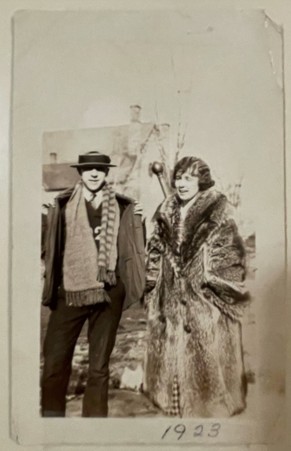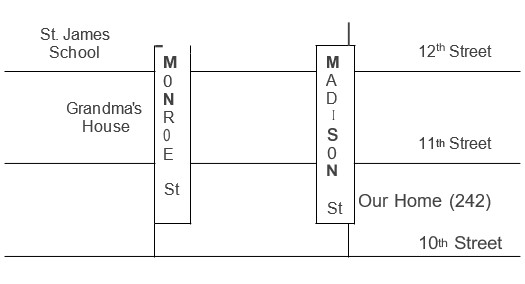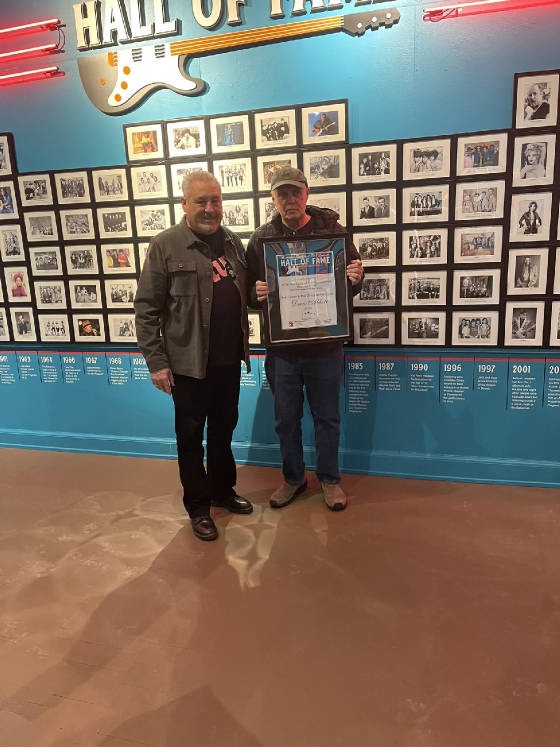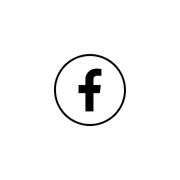|
Tuesday, April 8, 2025
12:41 pm edt
GUEST BLOGGER: MUDI'S MEMOIRS - PART 4
Written and told by Helen Kavanaugh Tobbe (1905-2002) and transcribed by her youngest child,
Kate Tobbe Ptak. When I was a freshman in high school, I had been horseback riding
with a friend a few times and really enjoyed it. A friend of the family, Mr. Carroll,
had a horse and was looking for someone
to exercise it. WP worked out an arrangement with Mr. Carroll so I could ride his
horse. The horse would be brought to our house, already saddled. One day, WP looked over
the horse as usual, before letting me ride. He didn't
think the saddle was on right, so he
adjusted it. I then got on the horse and went off
riding with my friend Margaret, whose father was a milkman. We were enjoying a good ride and decided
to ride over by the cemetery along a gravel path. Margaret suddenly decided to give
her horse a good run, and a stone from the path must have hit my horse, for it suddenly bolted. The horse took off down a paved
road, the saddle slipped,
I fell onto the concrete, and that's
how I broke my shoulder. High school was great fun because we had a good football team. There
were Friday night parties after each game. Jim Gates, a wonderful piano player, was
most happy to play all evening in the school gym. Then, to see which boyfriend would walk you home! Winter fun included ice skating down on the river, just a few blocks from home.
The big boats docked for the winter would put spotlights on the river, the city having scraped a long section for skating,
and for music we had two fellows playing their harmonicas. When the lights were turned out, we all scampered for the hot dog stand
on the street. I've never had a hot dog taste that
good since. In 1918 there was a terrible
flu epidemic. WP and Uncle Jerry Callahan both got the flu. A trained nurse was needed
to care for WP. We kids were sent to Grandma's until Dad got better, so we wouldn't catch the flu from him.
World War I was raging during
my high school years. The only family member I remember involved directly in the
war was my Uncle Bill, Nellie's youngest brother, who was sent to Dijon, France. Uncle Bill had bad eyes. He went into the recruiting office with a friend. Bill was accepted, but his friend
was rejected. Later, after Bill had
gone through basic training and was being shipped overseas, he found out the friend was rejected for having bad eyesight. Bill realized that their medical results had gotten mixed up, but it was too late to make any changes, so
off he went. 
Helen (Mudi) Kavanaugh's Uncle Bill, her mother's youngest brother. Source: Kavanaugh Family Files
My only other war related memories involved a German fellow who
was dating the daughter of one of our neighbors. There was no animosity towards him,
but he did get teased. I remember Jr.
and Louis Callahan (Uncle Jerry's son) would sell newspapers to him, calling out, "Extra, Extra, -News of the war with Germany!!". They'd sell a paper to him, then run away like hell before he'd realize it was a day old paper. Even during the couple's
wedding, Jr., Louis, and Teddy Vallee played a prank on that poor fellow.
WP was influential in Bay City business
affairs, and about 1919 or 1920 he was asked to run for the board of elections. In the process of preparing to do so, he discovered
he was not a U.S. citizen, so had
to apply for citizenship and take the test.
WP had been voting all this time, but to be sure that he passed, he felt
he needed to study for the test. Jr. and I teased Dad about needing to do his homework
and study for his big test. When I was in 10th
or 11th grade,
WP bought a fur coat for my Aunt Madeleine and bought one for me as well. I was really proud of that raccoon coat and wore it to school even in the spring. One day,
in early May, I had worn it to school. In those days girls were not allowed to wear short sleeves at school. If girls had short sleeved outfits
they could wear "sleevelets" which were long gloves with the hands cut out. I had a short sleeved
outfit on that day and got caught. After lunch, the
nun teaching the class called me on my short sleeves. I couldn't find my sleevelets,
so Sister told me to put on my coat. Rather than borrow a friend's jacket, I put on
my raccoon coat. I got a huge laugh when I sashayed out of the cloakroom
wearing that coat, but Sister got the last laugh when she made me wear that big heavy
coat for the rest of the HOT, HOT afternoon. 
Helen
Kavanaugh (Mudi) and John McGinty (1923). Source: Kavanaugh Family files. After high school, I went to college at Mary Wood in Grand Rapids, Michigan which was a long ride on the Michigan Central Railroad. (Today, it's about
a two hour ride by car) I had gained enough weight by the time I arrived home at
Easter, that I had to wear my school uniform all break - it was, let's say, a pleasant
year! The
following year I went to Ypsilanti Normal School which was a two-year course of study for teachers. My credits from Mary Wood transferred, so I only spent one year and a summer at the Normal School. (The normal school was incorporated later into Eastern Michigan University's Education Department in Ypsilanti
- The building is still there) My sister-in-law,
Pearl, was there at the same time I was and we stayed in the same boarding house near the school. I graduated from that program, earning a lifetime teaching certificate. In
1927, I got a job in the Detroit School System. They were not hiring too many new
teachers that
year, but because I asked for a black school,
I was hired. Although Lyons Public School was mostly a black school,
I was placed in a portable building about a mile from the main school. The portable
building was in Hamtramack an immigrant (all Polish and Slavic) neighborhood. I
taught Kindergarten & Irene Schindler taught first grade in the adjoining room. We became good friends sharing laughs
about our teaching experiences. I taught there for about two years. I remember one little boy who was a real troublemaker, and although
the kids at the school could barely speak English, this little boy, named Hillary,
sure knew all the English swear words! One day, I was fed up with Hillary's swearing,
so I hustled Hillary into the bathroom and showed him the bar of soap, threatening to
wash his mouth out with it. Later that day, I got worried that the parents
would get upset, so confessed to the principal
what I'd done. The parents were called and Hillary's father came to the conference. He was
a big, burly fellow. After hearing the story,
he stood up and took off his belt. I was afraid he was going to hit me with it -
instead he handed the belt to me, saying, "If he swears again, use this!"
Tuesday, March 11, 2025
HALL OF FAME INDUCTEES VISIT THE MUSEUM
by Gary Johnson
Musicians Larry McCray and Drew Abbott visited the Historical Museum recently to receive their framed induction certificates to the Michigan Rock and Roll Legends
Hall of Fame.
Larry McCray, who currently resides in Bay County, has emerged as one of Michigan’s top blues artists during
the past three decades. Born in Arkansas in 1960, his family moved to Saginaw in 1972 to take advantage of the economic opportunities
offered in Michigan’s automotive plants. It was there that Larry was introduced to the guitar and the transformative
music of important blues artists by his older sister, Clara. After graduating from high school, Larry took a job at a local General Motors assembly plant and began performing
at area bars and music clubs with his brothers Carl (bass) and Steve (drums) as the McCray Brothers. Larry’s guitar and vocals attracted the attention of Point Blank Records, and his first
two albums for the label, “Ambition” (1990) and “Delta Hurricane” (1993), garnered critical acclaim
for creating an exciting contemporary blues sound by fusing blues, rock, and soul. Throughout the years, Larry continued to help define blues rock by collaborating with artists
such as fellow guitarist Albert Collins, who was also signed to Point Blank. Playing music on national stages also allowed
him to meet and get to know on a first name basis blues heroes such as B.B. King, Buddy Guy, Albert King, Junior Wells, and
Luther Allison. In recent years, Larry has begun working
with Joe Bonamassa. “Blues Without You” was released in 2022, and he has a new album on Bonamassa’s label
set to come out in 2025. Drew Abbott was inducted into
the MRRL HOF as the lead guitarist for Bob Seger & The Silver Bullet Band. Drew is a native Michigander who started his
musical journey on drums before switching to rock guitar following the advent of The Beatles. He first gained attention as the lead guitarist in Third Power, a three-piece band that recorded
one album in 1970. After Third Power disbanded, Drew joined Bob Seger’s Silver Bullet Band in 1974 and appeared on Seger’s
“Seven” album. Starting with the “Beautiful
Loser” album in 1975, Drew was featured on six consecutive platinum albums by Bob Seger & The Silver Bullet Band.
The list included both the “Live Bullet” album, recorded at Detroit’s Cobo Arena, and the “Night Moves”
studio album from 1976, “Stranger in Town” (1978), the Grammy-winning “Against the Wind” (1980), and
a second live album, “Nine Tonight,” released in 1981. He left the Silver Bullet Band in the early ‘80s over a disagreement regarding Seger’s use of session
musicians on his studio recordings. Drew moved to Traverse City to start a family, and he went on to play in several different
bands in the years since. Drew and Bob Seger were reunited
in 2004, however, when Seger asked him to take the stage at his induction into the Rock and Roll Hall of Fame in Cleveland. Learn more about the Michigan Rock and Roll Legends Hall of Fame.
1:04 pm edt
Tuesday, March 4, 2025
GUEST BLOGGER: MUDI'S MEMOIRS - PART 3
Part 3: 1916 to 1919. Family life, Grade School Years
Written and told by Helen Kavanaugh Tobbe (1905-2002) and transcribed by her youngest child,
Kate Tobbe Ptak My brother Jack was a cute little kid. He was about seven years younger than Jr. and
I were. One day, when he was in third grade, he was walking home from school with his friend, Carny, who was from a very poor
family. They were walking past Grandma's house and Carny needed to get to a bathroom soon, so Jack invited Carny into Grandma's
to use the bathroom. Grandma wasn't home at the time. The two boys spotted freshly baked bread and a crock of jam. Jack, who
was a very friendly, hospitable child, invited his friend "poor Carny", to have some bread and jam with him. They
spread that jam nice and thick on their slices of bread. The jam was Grandma's Spring Tonic, made of honey, figs, and senna
(which is a strong laxative). After the snack the boys went on home. Jack didn't mention his visit, but Grandma knew someone
had been there, so she called and warned Nellie that someone was going to be very busy for a while. Well, Jack and “poor
Carny” didn't make it to school for two days - they were too busy. Those boys really cleaned out their systems. “Poor
Carny's” family was too poor to have indoor plumbing, so he really had a lot of running to do!  W.P and Nellie's Children. Bottom right: Helen (11/20/1905-3/4/2004), bottom left: Jack (1/20/1912-8/30/1939), top right:
WP Junior (1/25/1907-2/14/1997), top left: Margaret (4/3/1908-4/9/1996) W.P and Nellie's Children. Bottom right: Helen (11/20/1905-3/4/2004), bottom left: Jack (1/20/1912-8/30/1939), top right:
WP Junior (1/25/1907-2/14/1997), top left: Margaret (4/3/1908-4/9/1996)
I remember Sundays when we
were young. Of course, there was Mass in the morning, dinner, usually a roast chicken dinner with mashed potatoes and gravy,
(our main meal of the day) at noon, then we had to go back to church for Vespers and Benediction at 2:00. We used to pray
that the pastor wouldn't be feeling too good so we'd just have Benediction, as we had other plans starting at 3:30. When we
got out from church, we would run like hell all the way to the movies to get there on time. Pearl White starred in a serial,
The Perils of Pauline, that showed from 3:30 till' 5:00 PM. Each Sunday the movie would close with poor Pauline
hanging from the cliff or running from a Chinaman. What were our school days like? In first grade
we studied reading, spelling, phonics, catechism and math. In later years, geography, history, English, music and art were
added. Of course we had homework, but we would wiggle out of as much as we could. St. James School was located on 12th Street
and just down the street from the school was a blacksmith shop where we stopped every day after school. Did we stop in to
watch the smithy work? No, to hide our geography books which were too heavy to carry all the way home. He never minded or
squealed on us. Of course, our geography grades were seldom in the passing stage. We also went
home at noon every day for dinner. One time, Jr. and I were walking home for dinner with some cousins. As we approached the
cousins' house, we could smell freshly made bread and homemade catsup. Somehow, we wiggled our way in for dinner with them.
No one let Nellie know that we were there, and she got worried when we didn't get home as scheduled. Nellie checked with the
school and found that we were back in class, OK, so knew that we were all right, but Jr. and I sure caught hell when we got
back home later that afternoon. Grandma's house was on the way home from school, and we loved to
stop after school when bread had been baked that day. We also knew the cost - running errands; to the bakery, or maybe six
blocks to the drug store, or to the AOH (Ancient Order of Hibernians) with the insurance dues. Many times, we took a longer
route home. 
We had a sweet old nun for eighth grade who was so cross-eyed we never knew just who she was pointing
to when calling on students for answers. We got lots of exercise half getting out of our seats only to find it was Joe in
the next row she was calling on. One subject taught in the 8th grade was Indian Lore. WP had brought
home a statue of an Indian which he placed on top of the mantel in our living room. Nellie hated that "awful" thing,
so when she heard about the Indian Lore lessons, she quickly donated the statue to the class.
 I was fourteen when I started driving. There was no such thing as a driver's
license in 1919. WP had bought an old car for us, an Oakland. We and our friends referred to it as the Puddle Jumper. The
top had worn out, so the car was a permanent convertible. One friend, Mary Brysselbout, was a few years older than I. She
could play the organ and piano by ear. She played the organ at church for early Mass. I would take her to church in the Puddle
Jumper. If it was raining that particular day, Mary would open her umbrella to keep both of us dry. The car didn't last very
long with our family as Jr. smashed up the car by driving it into a ditch. I was fourteen when I started driving. There was no such thing as a driver's
license in 1919. WP had bought an old car for us, an Oakland. We and our friends referred to it as the Puddle Jumper. The
top had worn out, so the car was a permanent convertible. One friend, Mary Brysselbout, was a few years older than I. She
could play the organ and piano by ear. She played the organ at church for early Mass. I would take her to church in the Puddle
Jumper. If it was raining that particular day, Mary would open her umbrella to keep both of us dry. The car didn't last very
long with our family as Jr. smashed up the car by driving it into a ditch.
Photo of a 1916 Oakland Car Model 32 B. Mudi's "Puddle
Jumper" probable looked something like this, without the top. (Source: IMCDb.org)
2:47 pm est
Tuesday, February 4, 2025
GUEST BLOGGER: MUDI'S MEMOIRS - PART 2
Part 2: 1905
to 1916. Family life, first years Written and
told by Helen Kavanaugh Tobbe (1905-2002) and transcribed by her youngest child, Kate Tobbe Ptak I
was born November 20th, 1905, in a small home on 6th Street, Bay City, Michigan. It was further away from my Grandmother Callahan's
home than mother wanted to be. We moved to 12th Street, across from St. James Church and four houses from Grandma's
on Monroe Street. In 1908, Dad built 242 on Madison Street, one block over. Dad had built electricity into the house but also
included gas lighting because the electric wasn't reliable. By this time Jr. and Margaret were born. Then Mary Louise was
born in 1909, but she died six months later. 
242 North Madison. The home built by W.P. Kavanaugh
in 1908 for his family. Source: Kavanaugh Family Files Nellie
[my mother] was not very well after the death of Mary Louise. Aunt Mollie, mother's older sister, had married and
was living in Flint, Michigan. At that time, she had no children. She took me to Flint in September 1910 to help mother out.
She brought me home a couple of days before Christmas. About January 2nd, Aunt Molly told WP [William Patrick Kavanaugh,
my father], we would be leaving. Dad said, "We?" Molly responded, "Yes, Helen and I will go back to Flint
by train." "Oh, no! Helen is staying home." That's when Jr. & I
started kindergarten at Holy Rosary, a private school. Those days didn't last long because Jr. would have no part of cotton
balls, cutting and pasting, or daisy chains. He became a very disturbing kid and while not expelled from kindergarten, he
was not welcomed, so we both left. Can't remember much else about early school days, but to this day the smell of bananas
takes me back to that cloak room at Holy Rosary - guess that's why I never cared for bananas! WP's
first car was bought in 1911 or 12. It was a "Jackson". The roads were made of cedar block until about 1920. The
blocks were "rings" of cedar trees, set into the roadbed like tiles are set into a floor. I remember snowplows.
Of course, the streets weren't plowed - there was no need. Cars were put up on blocks over the winter. The snowplows were
for the sidewalks. A private company contracted with neighborhoods, street by street. If the residents of Madison Avenue wanted
their sidewalks cleared, they would hire the "plow''. This was a horse drawn wooden box on which a driver would sit,
with the front shaped like a wedge to push the snow aside. That front wedge was made of steel. In winter, WP would freeze
the side yard at the house and make a skating rink for the neighborhood. He also built a toboggan run from the roof of the
garage onto the driveway - the sleds would often end in the street. Another winter "sport" we enjoyed was catching
a ride on the back of the horse-driven sleighs travelling the roads. Of course it was "Verboten", but we would slide
off a few doors from home. We didn't roller skate much in the summer, because the sidewalks were made of bricks or boards
- not a good skating surface. 
The first three children of William Patrick (W.P.)
and Helen (Nellie), nee Callahan, Kavanaugh. Left
to Right: Margaret (4/3/1908–4/9/1996), Junior (1/25/1907–2/14/1997), and (Helen 11/20/1905–3/4/2004) Source:
Kavanaugh Family Files Our cleaning lady, Veronica, came several times a week.
While she was on her hands and knees scrubbing our kitchen floor with a big wooden bucket, Jr. would often sneak up and pull
her apron strings or jump on her back. That behavior didn't last very long as one time she just bent further over and let
Jr slide headfirst into the bucket of soapy water. One fourth of July, when Jr. was
about seven, he and a friend, named Major Cahalan, whose father worked for WP, caused a lot of excitement. WP always brought
firecrackers to be set off on the 4th. Besides safe items for kids to play with like sparklers and punk sticks, he always
had fireworks for display to be shot off after dark. Jr. and Major ran out of sparklers, so went to WP's car to look for more.
While they were rooting through the box of fireworks looking for more sparklers, one of the boys dropped his lighted punk
stick. The fireworks display came early that year. Earlier even than Jr. and Major expected, as they started off while the
boys were still looking for more sparklers. As Jr. got a little older, he would eavesdrop
while his dad and Bert Gafney, WP's lawyer, would talk business. When WP found him doing so, he invited Junior to join the
meetings. Jr. and I got along quite well, but he and Margaret, well, both thought they
were right! If Jr. said the moon was made of green cheese, I could care less as long as I didn't have to eat it, but Margaret,
wow! Our friends and neighbors on Madison Avenue included a very French family, a Jewish
family, an English family, and of course we were the Irish family. It made for interesting times. The French kids, the Vallees
lived across the street. They always wanted to swap their damned ginger snap cookies for my mother's good home baked cookies.
I still hate ginger snap cookies. We used to take them up on our back porch and see who could sail them the farthest across
the alley. The Vallees were a wealthy family who had five children. The father was the superintendent of the beet sugar factory.
The mother died when the youngest, Teddy, was still a baby. Teddy, who was Jr.'s age, was a fragile child. His older sister,
Marguerite, was my age. After the mother's death, the children's Grandmere came from France to live with the family. She never
spoke English. Jr. and I were often invited over to their house, which was very formal
with maids, etc. On Sundays, Mr. Vallee would often take the family for rides to Quaniquesee which was a zoo and park. Jr.
and I were often invited along. For these excursions, the chauffeur and Mr. Vallee would sit in the front seat, Grandmere
and the Vallee children would sit in the back seat, and Jr. and I were directed to sit on jump seats facing the back seat.
This was not a jolly excursion, for the family, especially with Grandmere along, was very stiff and formal. We hated these
outings and tried to wiggle out of the invitations, but all too often Nellie insisted that we go.
3:14 pm est
|

|
2025.04.01
2025.03.01
2025.02.01
2025.01.01
2024.07.01
2024.06.01
2024.05.01
2024.04.01
2024.03.01
2024.02.01
2024.01.01
2023.12.01
2023.11.01
2023.10.01
2023.09.01
2023.08.01
2023.07.01
2023.06.01
2023.05.01
2023.04.01
2023.03.01
2023.02.01
2023.01.01
2022.12.01
2022.11.01
2022.10.01

|




 W.P and Nellie's Children. Bottom right: Helen (11/20/1905-3/4/2004), bottom left: Jack (1/20/1912-8/30/1939), top right:
WP Junior (1/25/1907-2/14/1997), top left: Margaret (4/3/1908-4/9/1996)
W.P and Nellie's Children. Bottom right: Helen (11/20/1905-3/4/2004), bottom left: Jack (1/20/1912-8/30/1939), top right:
WP Junior (1/25/1907-2/14/1997), top left: Margaret (4/3/1908-4/9/1996)






